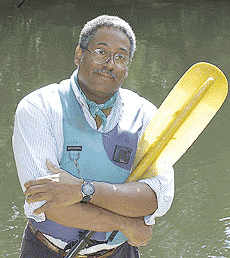|
|
 |
||||||||||
|
|||||||||||
|
|||||||||||
Changing a River’s Course
|
|||||||||||
 |
‘We can’t just hope everyone will do their best.’–Patuxent Riverkeeper Fred Tutman |
The pact would serve as a starting point for Patuxent River stewards to figure out how much farther we need to roll the boulder — and who must do the work — in the future.
With such a promissory plan, river protectors could hold counties and municipalities accountable for promises made. Though not a legally binding contract, the agreement would make it easy to determine who is and who is not doing their part. Not keeping promises would show: “They’d look silly, wishy-washy,” says Tutman.
During this next year, compacts will be drawn. By the Summit of 2008, next October, Tutman hopes to hold a mass signing.
Calvert County’s director of planning and zoning, Greg Bowen, says his county is up for the challenge.
“Standards have to be measurable and enforceable,” Bowen says. If they’re followed, he adds, “we will see major improvements to water quality.”
To guide the counties on their compact quest, riverkeeper Tutman has devised an action plan as a blueprint for what counties can promise. The plan came from months of intense homework as Tutman and his staff poured through river data and past research and interviewed local and state advocates, experts and decision makers.
After gathering comments from all seven Patuxent counties, the riverkeeper — with the blessing of the Patuxent River Commission — drew up drafts of their grassroots plan of action. It will be polished with more insights before the final copy is published in December as a guideline for the counties.
Budging a Boulder
The Patuxent compact — though not its specific promises — will be modeled after similar compacts, including the Eastern Shore 2010 Compact developed by the Eastern Shore Land Conservancy.
In the Eastern Shore Compact, counties made growth and planning promises, including directing 50 percent of all new development within designated growth areas by 2010. The six counties within the pact have been so successful — Kent County surpassed its goal by 90 percent — that they’ve amped up a new goal: 80 percent of new developments must fall in special growth areas for all counties.
“Putting numerics on goals is scary to local governments. Everyone says that they want to do planning and smart growth, but when you put numerics on it, that’s where you get resistance,” said Eastern Shore Land Conservancy executive director Robert Etgen. “We made our targets a reach but not an impossible reach for our counties.”
Etgen’s advice for the Patuxent River Compact is to get strong leaders to help you push your boulder. “Having key leadership — folks like Bernie Fowler — that are well respected on both sides of the aisle can’t be understated,” he told Bay Weekly.
On the other hand, some agreements don’t hold water. In the most notable Bay watershed promise — the Chesapeake Bay Agreement of 1983, resigned in 1987 and again in 2000 — Maryland, Virginia, Pennsylvania, Washington, D.C., and the EPA have failed to achieve their ambitious and well-publicized promises. Signatories talked no net loss of wetlands, developing management plans for invasive species and 40 percent nutrient reductions. Touted as the compact that would save the Chesapeake, it hasn’t stopped growing dead zones, increasing fish kills and murky waters.
“The very lofty aims of the Chesapeake Bay Agreement don’t provide an implementation framework,” Tutman says. In other words, the agreement didn’t spell out who was responsible for doing exactly what. That’s not a mistake the Patuxent River Pact will make.
Other compacts are doing better.
 |
‘If you’ve got sick fish out there, sooner or later, you’ll have sick people.’–Former State Senator Bernie Fowler |
“White Clay Creek in Delaware has B-rated water quality instead of the D rating applied to the Patuxent, because that river to the north has a federally ratified management plan,” according to the riverkeeper, who adds another success. “The Cuyahoga River in Ohio was a burning river until government and citizens stepped in and began actually managing the river to recovery.”
In the Lake Tahoe region, where tourism industries surrounding the lake depend on a healthy ecology to bring in visitors, Tutman says, “they have a compact that obliges the areas [and municipalities] to protect the environment.” Governors and the legislature of California and Nevada adopted the compact in 1972. It’s widely regarded as a success.
That’s the sort of success Tutman seeks.
Help from Above
“Signing of a compact is a good first step,” Patuxent champion Fowler told Bay Weekly. But, he says, “we need help from the state and federal government.
“One of things I’ve been screaming about for 35 years is to set a limit on nutrients — nitrogen and phosphorus — going into river,” Fowler says. “We engineered those limits in 1981, and we’re still trying to get the Department of the Environment to set the target limits.”
If the state follows his advice and the Patuxent River Compact works, Patuxent patriots will have found the leverage to get their boulder rolling.
|
Current Issue \\ Archives \\ Subscriptions \\ Clasified Advertising \\ Display Advertising |
© COPYRIGHT 2007 by New Bay Enterprises, Inc. All rights reserved.

